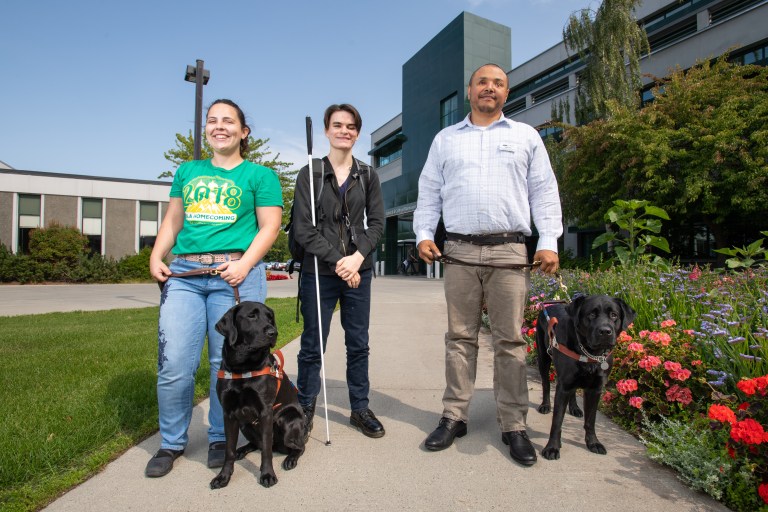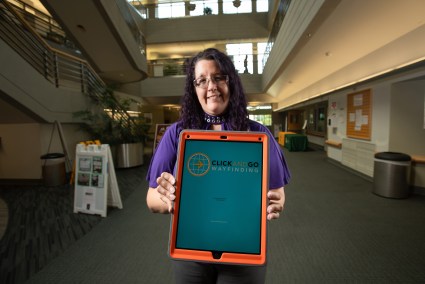UAA leads the way in technology for blind and low-vision students
September 3, 2019
It’s the beginning of fall semester at UAA and you’re running late for class, your stress level is already high. You pull into a parking spot, dash across the lot and pull out your schedule because you’re not exactly sure where you’re going. Now close your eyes and imagine trying to navigate this scenario as a blind student. For UAA’s blind and low-vision students, navigating UAA’s campus is an entirely different and sometimes stressful experience. But this year, UAA’s Office of Disability Support Services (DSS) is making “back to school” a little less stressful for the university’s blind and low-vision students.

A two-year project completed earlier this summer, through a grant from UAA’s Information Technology department, allowed DSS to hire ClickAndGo Wayfinding, a technology company specializing in developing products for the blind community worldwide, to install a beacon-based system across campus. The system connects to a Wayfinding App that not only provides visual map guidance, but audio as well. This new Wayfinding App and beacon system puts UAA on the cutting edge as the first university campus in the world to fully map and install a campuswide technology that is accessible and inclusive for blind or low-vision students.
“I think this will give students more confidence,” said Heather Swanson, UAA’s DSS assistive technology specialist, who’s worked on the project from start to finish. “But especially in the blind or low-vision community. If they get lost or turned around, that’s a major stress for them. I want to lower their stress and make sure they can be successful without getting lost.”
Beacons lead the way
The project began with DSS’s previous director when she and Swanson had a conversation
with a blind student who mentioned they kept getting lost on campus. The two decided
UAA needed to invest in a system that would better assist the university’s blind and
low-vision students.

“I think I spent about six months researching this,” Swanson said, who researched many different companies, as well as organizations from museums and hotels to airports and universities that had installed wayfinding systems in their spaces. “We ended up finding and working with ClickAndGo Wayfinding. This system is primarily for our blind and low-vision students, but we wanted a technology that everybody could use.”
The project was about two years from start to finish, first with ClickAndGo traveling to UAA and spending about three days mapping campus in summer 2018. The company spent the following year developing the system specifically for UAA and spent about a week this summer installing the beacons across campus.
Anne Lazenby, DSS’s current director, said it’s been a massive project, but hopes that this will help make UAA a more inclusive space for blind and low-vision students, as well as the community, or anybody visiting campus who might find it challenging getting around.
“One of UAA’s goals is to be inclusive of a diverse population and we weren’t; we didn’t have a way for blind and low-vision people to get around, and to me, this is a way to not only reach our goal but to also be accessible,” said Lazenby. “We’re showing the community that we care about accessibility and that people from all walks of life and abilities can get around on our campus.”
She said what’s even better is that several of UAA’s blind students were able to help in providing input during the installation. She said the ClickAndGo mobility specialists and students were able to point out issues that DSS and UAA’s facilities department hadn’t considered, like a water fountain jutting out into a walkway or an ill-placed cactus placed at the bottom of a stairwell, objects she said sighted people easily navigate around, but could cause harm to a blind or low-vision student.

“A blind person is not going to know that a cactus arm is sticking out in front of them and their cane’s not going to hit it,” Lazenby said. “We were able to adjust some of these potential walkway hazards around campus.”
Swanson and Lazenby both said that although the Wayfinding App was developed specifically for blind or low-vision people, that it’s a useful tool for sighted students or anyone coming to campus who is not familiar with the layout.
“This app, while it is primarily for blind and low-vision people, will help anyone,” Swanson said. “I’ve been on campus for about 10 years now and I still get lost, so new students can use it and for blind students, it just makes life a lot easier.”
Tactile maps
In addition to the Wayfinding App, DSS also installed two tactile maps, one on the first floor of Rasmuson Hall, outside of DSS’s offices, and one in the library. The maps are comprised of interchangeable metal plates that allow DSS to update the maps as needed.
The two tactile maps include braille as well as the names of buildings, parking lots, notable places and structures on campus. Lazenby said that UAA has always provided a visual map, but that this new tactile map is unique because of the braille, which means the campus map is now accessible to all students and visitors.
“We’ve now made the campus map accessible to everybody,” said Lazenby, using the example of someone searching for Beatrice McDonald Hall, who will now be able to not only visually see the location, but if they’re blind, or low-vision, will be able to use the braille on the map, coupled with the Wayfinding App to find it. “You can now actually find what you’re looking for [if you’re blind or low-vision].”

Lazenby said currently many buildings across campus do not have braille signage and would love to see that next step taken. But she said DSS is working toward creating a more inclusive campus and hopes that one day braille signage will exist in every building on campus.
“I hope that people see that we’re a welcoming, open environment,” Lazenby said, saying that the beacon-based Wayfinding technology and braille maps are an “outside the box” solution to a step in the right direction to becoming a more inclusive and accessible campus. “We want people to feel like they belong.”
A different perspective
“This technology kind of removes the barrier to a degree, it softens the sharpness of it,” said Nate Kile, a blind student pursuing his B.S. in business and computer technology, who uses both his phone and a guide dog to navigate across campus. “It gives us just a little bit of a more even playing field, independence and access without having to depend on people around us.”
He said that he and other blind students are not only thinking about the route they need to take to get to their next class but also all the obstacles they may encounter along the way, like a planter, stairs, elevators or chairs. It’s a more complicated process to get from point A to point B for them he said.
Kelsy Tallant, a psychology major, said, “UAA is a pretty big place and it can be quite confusing to get around.” She also relies on her guide dog to help her get to class and her job at the Student Information Desk in the Student Union. “To have this technology and have a more clarified version of directions is pretty great.” Tallant was also the first blind student to bring and use a tactile map to campus, which sparked the inspiration for creating and installing the two tactile maps on campus. She said working at the Student Information Desk, a major part of her job is helping students find their way, so she needed a map that she could read to help both sighted and blind students get around campus.
UAA student Aubrie Lucas interned last summer in DSS’s office and had the opportunity to help DSS, Facilities and the ClickAndGo Wayfinding team identify obstacles in walkways that could be problematic.

“I got to explore campus a bit more,” said Lucas of her involvement in the project. Previously to attending UAA, she had attended a university in the Lower 48 that had similar technology to UAA’s Wayfinding system, but that it wasn’t as effective or extensive. She often got lost and turned around and ended up coming home to Anchorage and attending UAA. She said before the Wayfinding App, it was a process to get from one part of campus to the other. “It was really slow-going and I would get where I was going eventually, but this technology seems good.”
Kile, Tallant and Lucas all agree that the new beacon-based Wayfinding App is a huge step in the right direction in creating a more inclusive and accessible campus, although they say there is still more the university can do. But, for the fall semester, they’re happy to have a little bit of relief, at least when it comes to finding their way across campus.
“This technology offers autonomy and independence,” said Kile. “I think this is a game-changer for current and prospective blind students because they are looking for colleges that have greater accessibility.” Which UAA is now not only an affordable, stay-close-to-home option but now an accessible one as well.
